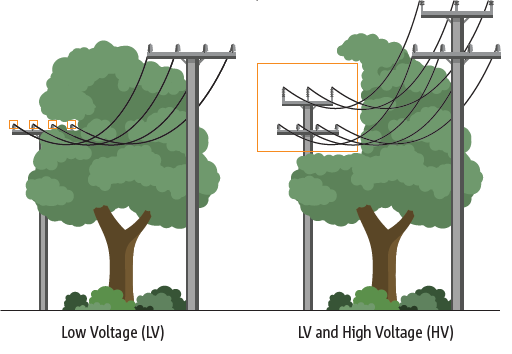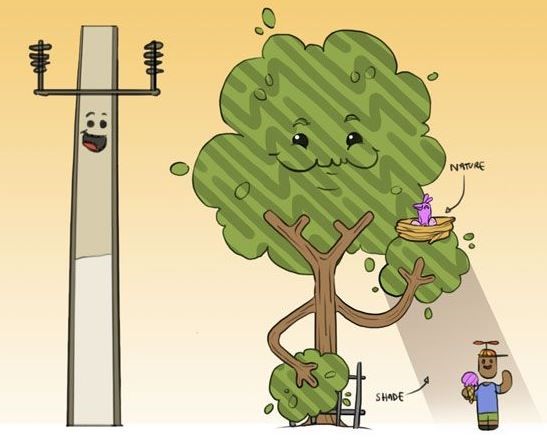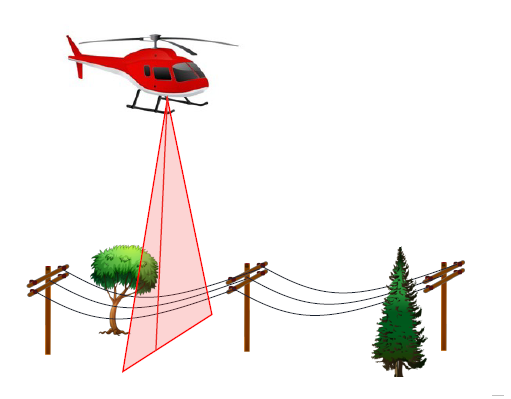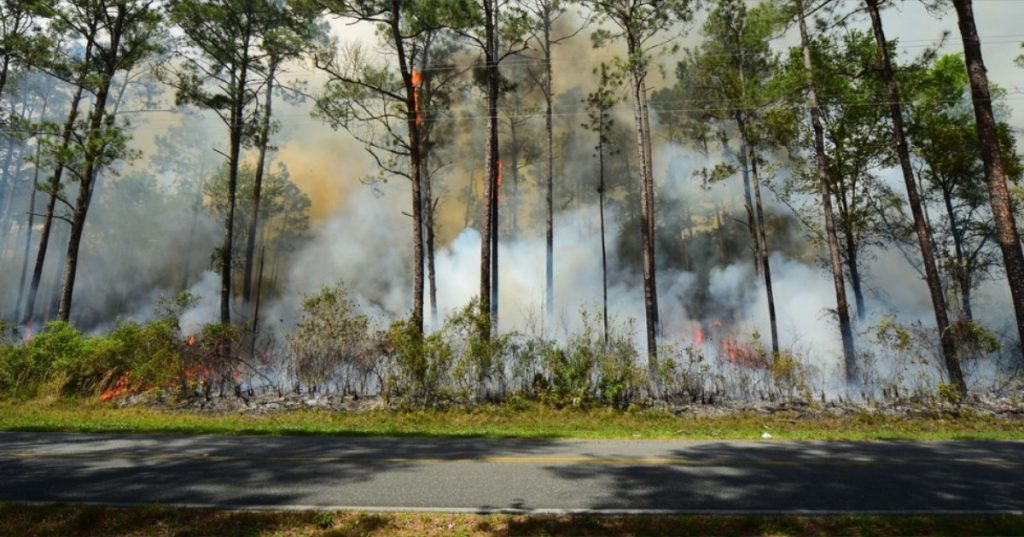Powering on for a safe summer
Ensuring safe and reliable electricity is delivered to customers through the hotter months can be challenging, with bushfire mitigation a key focus. In the lead up to summer, vegetation management is an important safety tool.
What is network safety?
Electricity is supplied from transmission (high voltage) to distribution (medium to low voltage) powerlines through to our homes. External factors can interfere with these powerlines and jeopardise network safety.
Network safety is like a tree with two main branches – one relating to people (occupational health and safety) and the other network and asset safety. Asset safety diverts into its own sub-branch of vegetation, bushfire, lightning and live line work [1].
Let’s trim out two sub-branches of vegetation and bushfire from our network safety tree and cross-examine them.
Vegetation and bushfire are two dominant and interrelated challenges that have kept networks on their toes for decades. Vegetation and bushfire can cause faults on powerlines, potentially causing fires and reducing reliability for customers.
Vegetation
Vegetation and trees are a natural part of our urban and rural landscapes and offer benefits for well-being and health. But their natural growth and movement in windy conditions can cause contact with powerlines, resulting in power outages and potentially bushfires in dry conditions.
Networks have obligations to undertake vegetation clearance around powerlines to ensure community safety and reliability of electricity supply. Maintaining clearance distance between vegetation and powerlines is fundamental to network safety and minimising the risk of bushfire.
Lesser clearance distance is required for low voltage (LV) lines, while greater clearance is needed for high voltage (HV) to maintain network safety. Pruning trees to minimise customer outage risk and bushfire starts is one of the largest recurring operational costs to networks [2].
Networks working together with communities
SA Power Networks (SAPN) has been on a journey for the past five to 10 years to meet its regulatory obligations while reducing vegetation clearance and balancing growing community expectations.
In collaboration with councils, landholders and communities, SAPN has developed a protocol for vegetation management near powerlines. It also carries out residential surveys after cutting trees to determine customer satisfaction and understand customer concerns [3].
SAPN has developed a powerline-friendly list of tree species customised to different regions and environments, in consultation with local councils and the nursery industry, to ensure the right tree is planted at the right places. SAPN is also working on alternatives to regular pruning, including tree removal and growth regulator trials.
A major step forward for SAPN and urban streetscapes in non-bushfire areas was a change in clearance regulations allowing a risk-based approach to pruning around LV powerlines. This approach, as shown in Figure 1, allows trees to grow through and close to LV powerlines and has been applied in metropolitan Adelaide and few regional towns.

Figure 1: Pruning around different voltage powerlines in South Australia (source: SAPN)
Community engagement has resulted in reduction in all customer complaints from about 15 per cent to just four per cent over the past five years. Through this, SAPN has attained greater understanding of its regulatory requirements as well as built positive relationships with its communities [4].
Figure 2 illustrates an education and information program formulated by SAPN that educates the public about managing risk of trees near powerlines.

Figure 2: ‘Trev the Tree and Stan the Stobie’ (source: SAPN)
Innovation in Vegetation Management
Networks such as CitiPower, Powercor and AusNet Services are pursuing innovation in Light Detection and Ranging (LiDAR) as an asset inspection tool in vegetation management. Similar to a radar, LiDAR uses pulses of laser light to measure distance from air to powerline and surrounding vegetation as depicted in Figure 3 [5].
LiDAR measures clearances and helps predict vegetation growth and replaces the need for costly manual surveying. Consequently, it assists networks to reduce unnecessary vegetation cutting or cutting more often where needed. LiDAR also allows networks to determine compliance more accurately.

Figure 3: Using LiDAR for vegetation management (Source: Citipower Powercor)
Bushfires
Bushfires are preceded by high temperature, strong winds and low humidity. Climate change has also led to increased duration of declared fire seasons and more frequent extreme days. Earlier this month, there were scores of bushfires raging across Queensland in what was described as the worst known start to the state’s bushfire season.
Vegetation that is close to powerlines may damage them, but vegetation management minimises this risk. What is harder to manage is wind-blown tree debris that originates outside of the clearance zone and some distance away from the powerline.
The economic, social and environmental impacts of severe bushfires have been felt extensively throughout south-eastern Australia in recent decades. The 1983 Ash Wednesday bushfires and Black Saturday in 2009 both had devasting impacts on communities and resulted in extensive damage to network infrastructure [6].
Single wire earth return (SWER) lines comprise thin and typically long conductors. Under certain fault conditions, such as when a tree falls over a powerline on a windy day, the SWER conductor is prone to breaking and can fall to the ground or into vegetation. This can create a short circuit fault, which in the right conditions has a high risk of starting a bushfire [7].
The Black Saturday fires began with the Kilmore East fire when a SWER conductor fell to the ground and started a blaze in farmland that quickly spread through a pine plantation. This is an example of how bushfire starts from powerline faults and how vegetation works as a fuel. Networks are using innovative techniques to mitigate against bushfires.

Innovation in bushfire mitigation
In Victoria, the legislative framework that governs networks relating to vegetation clearance and bushfire mitigation is the ‘Electricity Safety Act’, which focusses on [8]:
» safety of electricity supply and use;
» reliability and security of electricity supply; and
» efficiency of electrical equipment.
AusNet Services and CitiPower Powercor have significantly changed their approach to vegetation and asset management, with very detailed and targeted programs of work directed at minimising bushfire risk from powerlines.
This has led to installation of world-first technology, Rapid Earth Fault Current Limiters (REFCL), which quickly detects faults and reduces bushfire risk.
Risk modelling also helps networks to economically assess cost versus benefits. AusNet Services and CitiPower Powercor are utilising fire loss consequence modelling for risk modelling and have focussed network investment in highest risk areas. They are also using smart meters to detect faulty LV equipment.
United Energy (with support from AusNet Services and CitiPower Powercor) is developing a new low cost control tool known as ‘broken conductor fault detection technology’ on SWER powerlines for bushfire mitigation [9]. United Energy is also embracing REFCL technology. Its REFCL program has not been mandated by Energy Safe Victoria but is being rolled out to deliver network safety improvements for the Mornington Peninsula community.
Evoenergy in the ACT is also using a device known as Pulsecloser IntelliRupter for bushfire mitigation. It uses less energy to test for fault and reduces stress to the powerline.
Safety First
Australian networks are faced with incredible challenges maintaining safety, especially when related to vegetation and bushfire. Vegetation management and bushfire mitigation have the highest priority as summer approaches. It is also vital that people living in bushfire prone areas have a bushfire preparedness plan.
Message to customers from networks:
Despite the significant investments to reduce bushfire risk, powerlines still pose a hazard and are not the only cause of bushfires. If you live in a bushfire prone area, know the importance of having a bushfire preparedness plan. Make sure your plan is up-to-date and remember that on total bushfire days there is a higher than normal chance of power being off, so make sure your plan doesn’t rely on electricity such as an electric water pump for firefighting.
References
[3] https://www.sapowernetworks.com.au/public/download.jsp?id=311919
[4] https://www.sapowernetworks.com.au/public/download.jsp?id=310705
[5] https://www.powercor.com.au/safety/bushfire-mitigation-program/year-round-program-of-work/
[7] https://knowledge.aidr.org.au/resources/bushfire-black-saturday-victoria-2009/
[8] http://www8.austlii.edu.au/cgi-bin/viewdb/au/legis/vic/consol_act/esa1998209/
